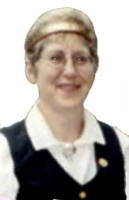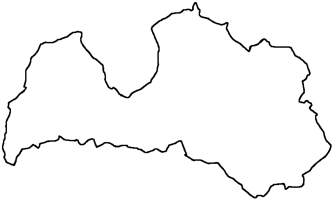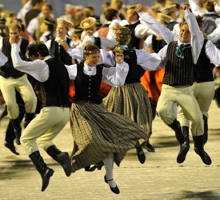
|
The Society of Folk Dance Historians (SFDH)
Latvian History and Culture
[
Home |
About |
Encyclopedia | CLICK AN IMAGE TO ENLARGE |

|
 I am of Latvian descent, born in Germany. What I know of Latvia is from my parents and other Latvians, from my three visits there, and from reading. Here is a very brief history of this country.
I am of Latvian descent, born in Germany. What I know of Latvia is from my parents and other Latvians, from my three visits there, and from reading. Here is a very brief history of this country.
The ancestors of present day Latvians came to the Baltic area around 2,000 BCE, and by the first millennium CE Latvia's principal river, Daugava, was at the head of an important trade route. During the medieval period, Latvia's capital, Riga, was founded by Germans, and the country became a prominent member of the Hanseatic League. This cultural group occupied the country until the 16th century, and to this day there are still Baltic Germans who trace their ancestry back to this time. Also, many Latvian words have been influenced by the German language. Sweden and Russia played a large part in controlling Latvia after 1710, but Russia became dominant. During the 1905 Russian Revolution, some Latvians escaped from their homeland and emigrated to the west.
Latvia finally won sovereign independence in 1918, and adopted its own constitution. This independence, however, was short lived because of economic instability, and a plethora of political parties, that led to the establishment of a dictatorship in 1934. In 1940, Latvia was incorporated into the Soviet Union, then in 1941, the Nazis took over, and finally in 1944-45, the Soviets reclaimed it. In 1991, at the time of the fall of Communism in Soviet Russia, Latvia became a free and independent country again, and remains as such today. The year 2018 was very important in Latvian history because it celebrated the independence it gained 100 years before. It is now free of foreign occupation.
It is a member of the United Nations, of the North Atlantic Treaty Organization (NATO), and the European Union, all in an effort to improve its economic status and to keep the Russians at bay, both with varying success.
 As mentioned earlier, many Latvians fled to other countries during the 1905 Revolution. But after World War II, things became even worse. Thousands of people from the Baltic countries were slaughtered or sent to Siberia for no good reason; many were just in the wrong place at the wrong time. Great numbers perished under the harsh living conditions there. As the Nazis were retreating and the Communits were taking over, thousands of Baltic people were fleeing. My family escaped to Germany, where we lived in DP (displaced persons) camps for three years. Both my sister and I were born there. The main contries accepting refugees were Brazil, Australia, England, Sweden, the United States, and Canada. We had a sponsor in Canada so we came here when I was one year old and settled in northern Ontario, near Timmins, where we lived for eight years.
As mentioned earlier, many Latvians fled to other countries during the 1905 Revolution. But after World War II, things became even worse. Thousands of people from the Baltic countries were slaughtered or sent to Siberia for no good reason; many were just in the wrong place at the wrong time. Great numbers perished under the harsh living conditions there. As the Nazis were retreating and the Communits were taking over, thousands of Baltic people were fleeing. My family escaped to Germany, where we lived in DP (displaced persons) camps for three years. Both my sister and I were born there. The main contries accepting refugees were Brazil, Australia, England, Sweden, the United States, and Canada. We had a sponsor in Canada so we came here when I was one year old and settled in northern Ontario, near Timmins, where we lived for eight years.
There are many stories of people enduring bombers and battles while fleeing, taking overcrowded leaky boats across to England and Scandinavia. Families were separated, husbands and wives often did not see each other again. Everyone thought that our new homes would be temporary, that everyone would return to Latvia after things had settled down, but this was not to be. When the Communists left, people began to return, but those who were born outside of Latvia did not feel the same attachment to the motherland. Most have visited Latvia, some have returned to live, but for many their new country is their home.
Latvians have a very rich culture: singing, folk dancing, poetry, jewelry, handiwork, pottery, and food. They use a lot of amber in their jewelry, produced by the pine forests dating back more than 40 million years. Amber is often found on the beaches of the Baltic Sea.
Latvians have a close connection to their folklore roots, and many of their songs and poems deal with nature, the sun, and the land. It has the largest known collection of folk songs.
Every five years, there is a Song and Dance Festival begun in 1873, during which there is a concert where up to 30,000 amateur singers take part; choirs come from all over the world to sing at this event. There are two main concerts; one secular, the other religious. The secular one contains choral singing, but also folk songs. The folk dance event, that was added in 1948, can have up to 17,000 dancers, also from all over the world. Latvian folk dancing focuses on geometric patterns, rather than footwork, and usually is very energetic. There have been similar festivals in the United States and Canada as well, but they are always on a much smaller scale. Lately, they have been shrinking even more, because of Latvians who set up this tradition in their new homes no longer have the energy to stage these events. During these extravaganzas, one also can attend plays, art exhibitions, readings by authors, as well as evening dances and dinners. And there always is a competition of new folk dance choreographies.
The largest annual event is St. John's Day, a national holiday in Latvia, celebrated June 23rd. It is a celebration of nature and goes back to Latvia's pagan roots. People wear wreaths on their heads: the men's are made of oak leaves, the women's of flowers, usually daisies. Big bonfires are built, and the tradition is that young men try to jump over the fire. People drink beer and eat special cheese, staples at this event. If a man's name is John, this is a significant day for him: it's his name day. There is a collection of special songs sung telling of John's exploits and of life in the villages at this time. Young people try to stay up all night, and may succeed. This celebration also takes place in the Diaspora – it's a great party!
Latvians have many folk costumes from each region of Latvia. The skirts of the women are made of wool, and their white blouses are of linen. Latvian designs are used in the weaving of these garments. Men usually wear gray pants and white linen shirts, frequently with a vest. The women wear white stockings, and often the men wear tall black boots, sometimes a hat. Married women usually cover their hair with a kerchief; single girls have a small wreath made of fabric and metal, or of flowers. There are many, many variations on this basic theme; whole books have been put together illustrating the styles of costumes.
In spite of the many hardships the Latvian people have endured, they are a hardy lot, friendly, and proud of their homeland. Just as with other oppressed peoples, they feel a need to teach the next generation about their past struggles, their language and traditions, and their culture.
DOCUMENTS
- Latvia, a country.
- Baltic States, a region.
- Europe, a region.
Used with permission.
Printed in Folk Dancer Online, April 2018.
This page © 2018 by Ron Houston.
Please do not copy any part of this page without including this copyright notice.
Please do not copy small portions out of context.
Please do not copy large portions without permission from Ron Houston.